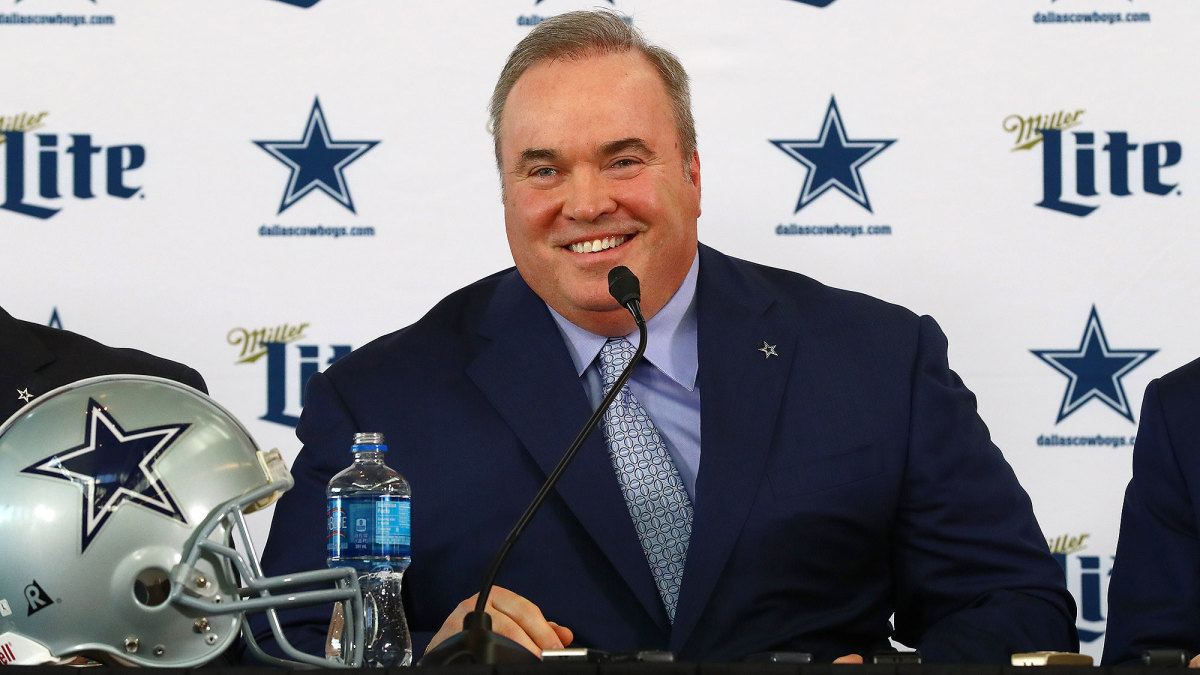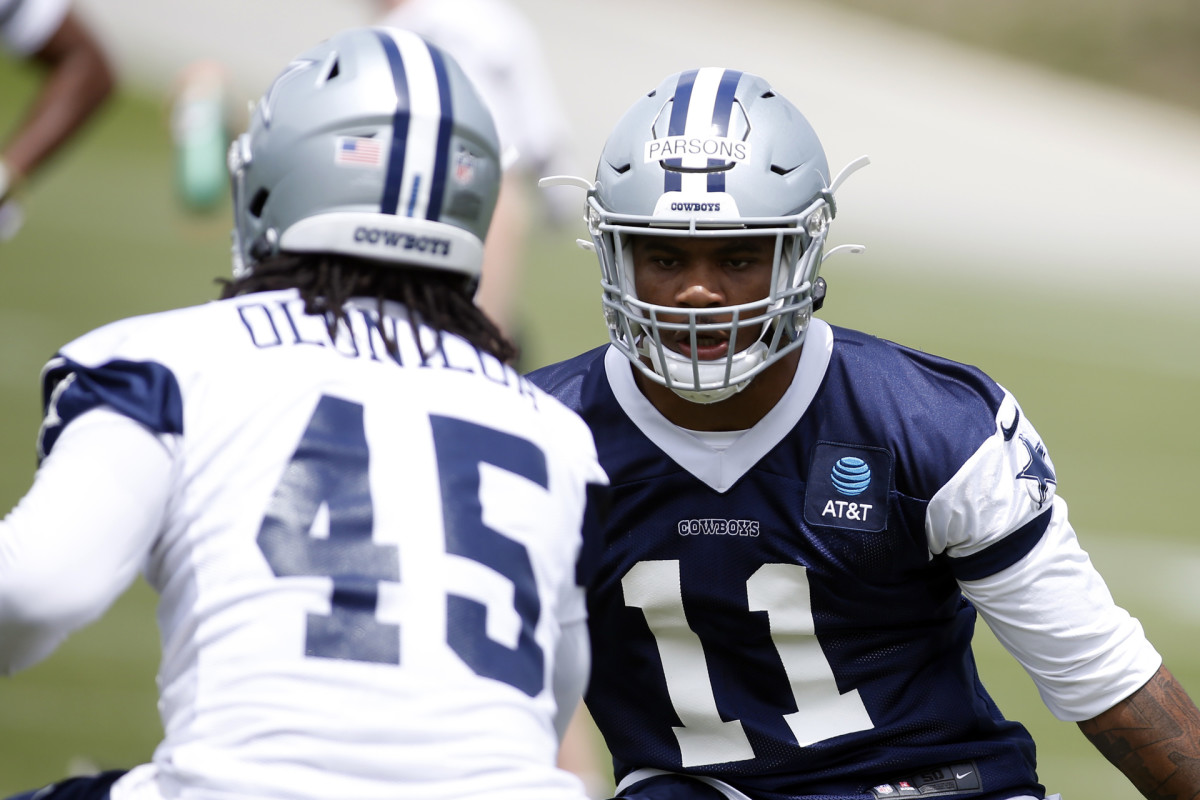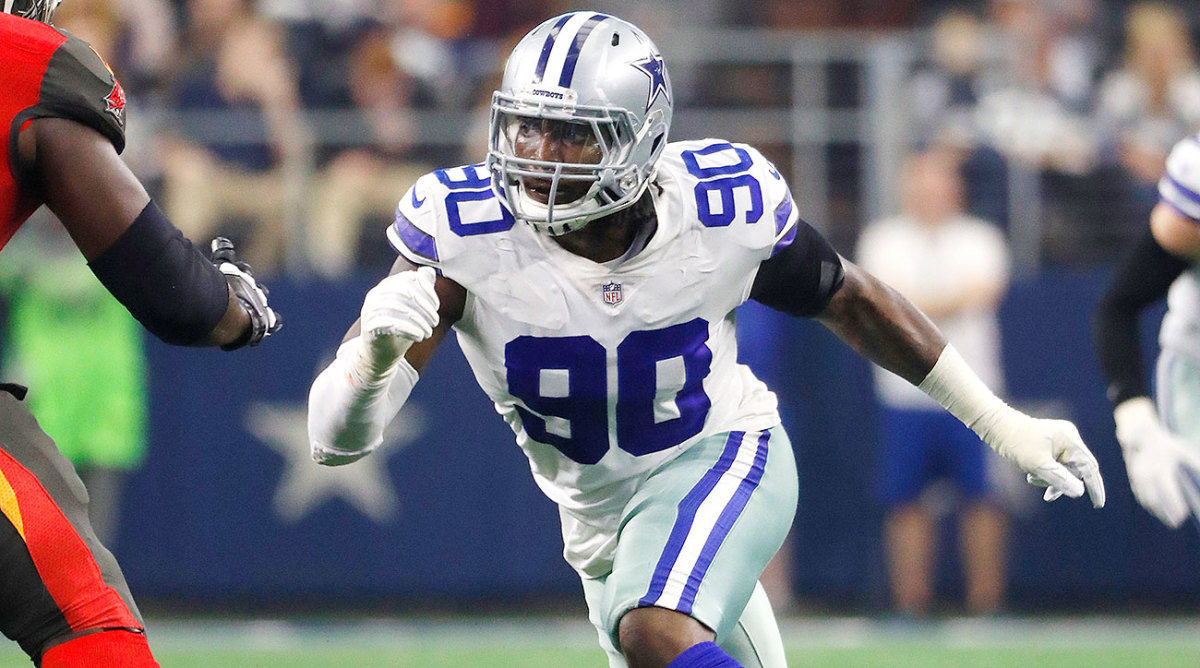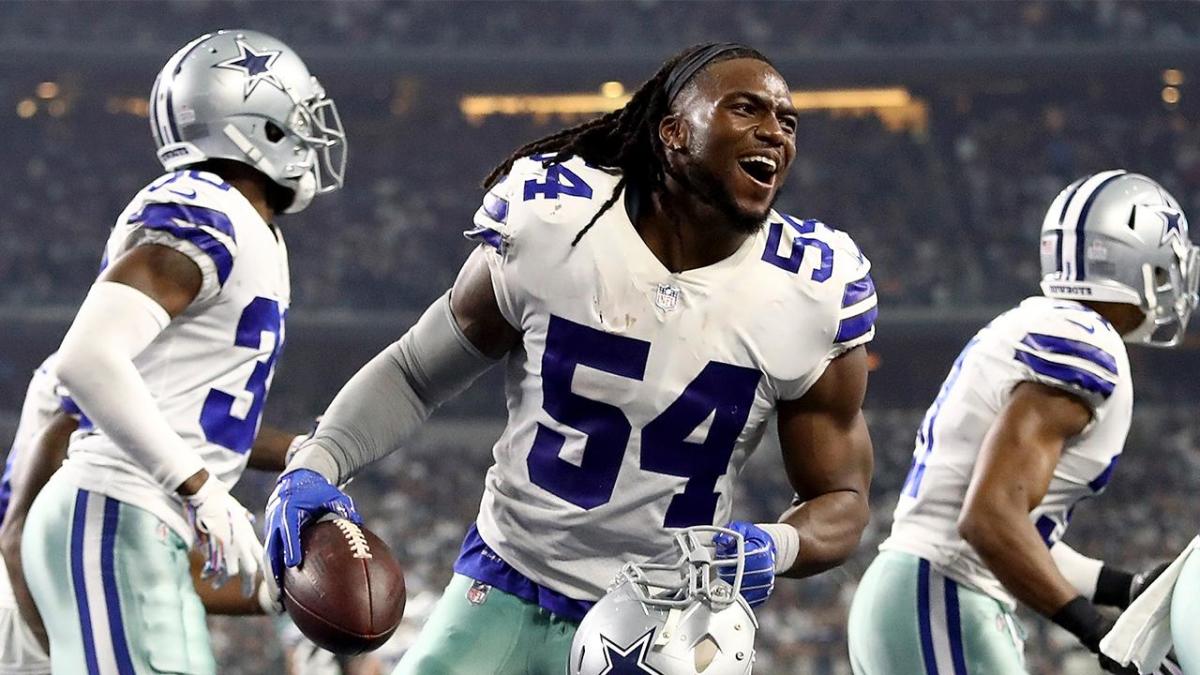2021 Dallas Cowboys Fantasy Team Outlook: Move Over Mahomes, Here Comes a Healthy Dak Prescott
Coaching

In his first season with the Cowboys, Mike McCarthy went 6-10. He had a successful 11-year run (114-61-1) with the Packers, leading to nine trips to the postseason and a Super Bowl win in 2020. Over his final two seasons with Green Bay, he went 11-16-1. Dallas made playoffs three times over the six years before McCarthy arrived while compiling a 56-40 record.
Last year the Cowboys fell to 14th in offense yards after losing their starting quarterback in Week 5. They finished 17th in points scored (395), 39 fewer than in 2019 (434).
Kellen Moore returns to run the Cowboys’ offense for a second season. He went from backup quarterback from 2012 to 2017 with the Lions and the Cowboys to a quarterbacks coach in 2018. Moore starts the year at age 32, putting on a path to a head coaching job down the road.
Their defense fell apart in 2020, leading to a fade to 23rd in points allowed (473) and 28th in yards allowed. Dallas gave up 152 more points than 2019 (321).
Regression on defense led to the Cowboys hiring Dan Quinn to be their defensive coordinator. Over five-plus seasons as the head coach of the Falcons, he went 43-42 with a trip to the Super Bowl in 2016 and another postseason appearance the following year. His defense helped the Seahawks win the Super Bowl in 2013. Quinn has been an NFL coach since 2001.
Free Agency
The only offensive changes via free agency for the Cowboys were the loss of QB Andy Dalton and the addition of T Ty Nsekhe.
Dalton went 4-5 in relief of Dak Prescott, but he gained only 6.5 yards per pass attempt. Over 10 seasons, he had a 74-66-2 record with no wins in four chances in the postseason.
Nsekhe provides bench depth to their offensive line. He has never been a full-time starting player.
Their defense lost CB Chidobe Awuzie, S Xavier Woods, and DE Aldon Smith.
More Dallas Cowboys Coverage from SI
The Cowboys added S Keanu Neal, DE Tarell Basham, and DT Brent Urban.
Neal is a talented player with a first-round pedigree (2016). He missed almost all of 2018 and 2019 with injuries. Neal played under defensive coordinator Dan Quinn, where he flashed upside in all areas. His play should improve the Cowboys’ run defense. Neal will give up catches, but receivers tend to gain short yards per catch.
Basham improved defending the run over the past two seasons with the Jets while working off the bench. He has 5.5 sacks over his last 32 games.
Urban projects as a rotational player with early-down value in run support. He has never had over 2.5 sacks in any season.
Draft

LB Micah Parsons
Parsons should be a high-volume tackler with the speed and quickness to excel all over the field. His next step is finding a balance between attack and patience to help him find his assignments on time. He needs to improve his transition when facing traffic against blockers. Parson has the potential to add much more production in the pass rush.
CB Kelvin Joseph
Joseph brings the physical tools to support the run and work well in press coverage. His reads lack confidence at times, which should improve with more experience. Joseph can get unwound in the heat of the battle, leading to cheap shots and penalties. Quarterbacks will have success manipulating him with their eyes early in his career.
DT Osa Odighizuwa
Odighizuwa wins off the line with a disruptive first step, with the vision to keep an eye on his mark in the run game. His motor runs hot, helping him push to the quarterback. His challenge comes when facing bigger bodies on the interior of the defensive line. Odighizuwa plays too fast on some plays, inhibiting his success rate when adding a secondary pass rush move. The Cowboys' task is finding the correct position to play him in.
DE Chauncey Golston
Golston looks to have a misplaced skill set at this point in his career. He offers better success rushing the quarterback on the inside, despite having the build (6’5” and 270 lbs.) to play on the outer limits of a defensive line. Golston loses value when rushing the quarterback off the corner, which may come when adding more strength. For now, only a passing rushing option with plenty of questions about his run defense.
CB Nahshon Wright
Wright has a good feel for reading pass routes with the length to cover a big window over the short areas of the field. Unfortunately, his long speed is lacking, leaving him in the dust if beaten early in pass routes. He may develop in press coverage if his body (185 lbs.) catches up to his height (6’4”). His technique needs work when trying to match wide receivers in pass routes. I expect him to be a better player in red zone coverage.
LB Jabril Cox
Cox made the jump to a top college program in 2020 with minimal regression in his play. His attacking style improves a run defense, but Cox still has a looker feel, which leads to a slower first step out of his breaks. He will add value in pass coverage. Overall, Cox is an improving player with a chance to have success on all three downs.
T Josh Ball
An off-the-field issue led to Ball sliding below his talent and ceiling in the draft. His pass grades are ahead of his run blocking skills. He wants to protect the outside in the pass rush, leading to inside pressure by defenders cutting across his face. Ball fires into defenders, which can cause balance issues if missing his mark.
G Matt Farniok
Farniok adds flexibility and depth to the Cowboys’ offensive line. His game plays the best in a quick-hitting run game. He should handle most bull rushers while needing to improve in pass protection.
WR Simi Fehoko
He has a one-trick pony feel due to his lack of route running and questionable short-area quickness. His intrigue comes over the long field where Fehoko owns an edge in size (6’4” and 220 lbs.) while offering sneaky build-up speed.
DT Quinton Bohanna
Bohanna will be an early-down run clogger with minimal chance of seeing the field on passing downs. He plays with power with enough of a first step to put offensive linemen on their heels. His range is limited while losing value with each step away from the middle.
CB Israel Mukuamu
Mukuamu owns an edge in size (6’4” and 210 Lbs.) that should play well in press coverage in the red zone. His foot speed out of an early release could lead to some issue over the long field. His run support is trailing while lacking the foundation in his footwork to match top receivers in their route running.
Want even more fantasy and betting analysis? Become an SI Fantasy PRO member today and start beating the books and winning your leagues with us!

Offensive Line
Dallas faded to 16th in rushing yards (1,788) with only seven touchdowns and 10 runs over 20 yards. They averaged 26.9 rushes per game and 4.2 yards per carry.
The Cowboys dipped to seventh in passing yards (4,511) with 25 touchdowns and 13 interceptions. They gained only 7.1 yards per pass attempt with 50 passes over 20 yards. Their offensive line allowed 44 sacks. The loss of Dak Prescott led to a much weaker passing offense over the final 11 games.
LT Tyron Smith
Over the last five seasons, Smith missed 27 games with knee, ankle, neck, and back issues. He played only two games in 2020 due to a neck injury that required surgery. He remains a top pass-blocker while having a winning resume in the run game. Dallas expects him to be ready for training camp.
LG Connor Williams
After struggling in his rookie season, Williams tore his ACL in his left knee late in November in 2019. He has a strong foundation in his technique, which gives him the most upside in run blocking. Williams improved slightly in pass protection last year while becoming an asset in the run game.
C Tyler Biadasz
Dallas added G Tyler Biadasz in the fourth round. His foundation skill set grades well while also offering plus hands and an excellent feel for his blocking assignments. Biadasz comes up short in pass protection and his ability to make run blocks outside his initial defender.
In his rookie season, he made four starts while failing to make an impact in any area. Biadasz missed five games with a hamstring issue.
RG Zack Martin
Martin has been a beast in pass protection in his seven-year career while also offering an excellent foundation in run blocking. The Cowboys drafted him in the first round in 2014. He missed six games last season due to a calf injury.
RT La’el Collins
In 2019, Collins made a move from underachiever to an elite asset on the offensive line. He dominated in the run game while showing more growth in pass blocking. A hip injury led to him missing all of 2020.
OL Snapshot
Injuries at quarterback and on the offensive line led to Cowboys underperforming on the ground and in pass protection in 2020. They still have three top-tier players, leading to a rebound in all areas this season. The center position looks messy, while Conner Williams remains an unknown.
Offense
Dallas finished second in pass attempts (639) while rushing the ball just over 40 percent. With improved defensive play, the Cowboys will be more productive on the ground. They have the receiving talent to push up the rankings in scoring and passing yards.
Quarterbacks
Dak Prescott
After four games, Prescott was on a blistering pace in passing yards (6,760), highlighted by three impact games (468/4, 498/3, and 514/4). His season ended in Week 5 due to an ankle injury that required surgery. He set career-highs in his completion rate (68.0) and yards per pass attempts (8.4). Prescott had 25 completions of 20 yards or more. Over his past 21 starts, he completed 22 passes that gained 40 yards or more.
The defense's demise pushed Prescott to the air 50 times over his first four games. Dallas has elite wide receiving talent, plus the complementary pass-catchers out of the backfield and tight end. He also has 24 rushing scores over his first 69 matchups. Prescott averages 5.1 yards per rush while gaining 19 yards on the ground in his career.
Fantasy Outlook: In mid-June, Prescott is the fourth quarterback drafted in the 12-team high stakes market. I fully believe in follow-through in 2021. Over a 17-game schedule, he looks to be on a path for 5,500 combined yards with 40+ combined scores which should challenge the game's best for top-scoring QB.
Other Options: Garrett Gilbert, Ben DiNucci, Cooper Rush
Running Backs
The Cowboys’ running backs combined for 2,060 yards in 2020 with 14 touchdowns and 81 catches. Their backs saw a regression in yards per rush (4.1) and yards per catch (6.5). Part of the downturn was due to injuries on the offensive line and downgrade in quarterback play. Dallas needs to regain this bounce in their step running the ball, especially in the red zone.
Ezekiel Elliott
The running lanes shrunk in 2020, leading to Elliott having the lowest production of his career. He gained only 4.0 yards per rush with more fade in his yards per catch (6.5). When at his best in his rookie season. Elliott was much more explosive in all areas. His offensive line ranks well but below his early seasons in the league.
He rushed over 100 yards in only two matchups (21/103 and 19/105). The Cowboys gave him 19.7 touches per game, which was below 2018 (25.4) and 2019 (22.2). Elliott caught over 50 passes in each of his past three seasons. Over his last 545 rushes, he gained 20 yards or more on only seven plays. In 2020, none of his 52 catches reached the 20-yard mark.
Fantasy Outlook: The positives to his opportunity in 2021 should be a much healthier and talented offensive line, plus Dallas will have one of the highest-scoring offenses in the league. Tony Pollard will steal some of his chances, but Elliott could very well explode this season. With an ADP of 7 in 12-team leagues, he will be a trusted asset with a high floor and possible explosive ceiling. My bet is on 16 scores with 1,800 combined yards and 50 catches.
Tony Pollard
In his second season, Pollard gained 628 combined yards with five touches and 28 catches on 129 touches. He finished 41st in RB scoring (121.30) in PPR leagues with one highlight game (132 combined yards with two touchdowns and six catches in Week 15 when Ezekiel Elliott didn’t play.
Over his first five games, the Cowboys only gave him 20 touches, leading to 100 combined yards with a touchdown and seven catches. Dallas leaned on him more over his next eight games (342 combined yards with two touchdowns and 11 catches on 73 touches).
Fantasy Outlook: Pollard has underachieved his draft value over his first two seasons with Dallas. He remains a high-end handcuff while being an injury away from a top 12 opportunity. His ADP (114) looks favorable when adding that his role should increase in 2021. His next step should be 175 touches with 800 combined yards, 35 catches, and five to seven scores. Pollard should inch closer to being a viable flex play in PPR leagues.
Other Options: Rico Dowdle, Sewo Olonilua, Brenden Knox, JaQuan Hardy
Wide Receivers
If Dak Prescott stayed healthy all season, the Cowboys’ wideouts would have pushed to one of the top combos in the league. Their wide receivers accounted for over 70 percent of Dallas’s passing yards for the second straight year. Despite a rise of 32 catches, they gained fewer yards (12.6) per catch, leading to a slide in receiving yards (3,235) and touchdowns (17).
Without a doubt, Lamb will be a target in drafts this season. He finished his rookie season with 74 catches for 935 yards and five touchdowns on 111 targets. Lamb gained over 20 yards on 18 catches while also adding some production on the ground (10/82/1).
His season started with 36 catches for 497 yards and two touchdowns over six matchups. His best value over this stretch came in three games (6/106, 5/79/2, and 8/124). Andy Dalton struggled to get him the ball over his next seven games (25/245/2) while gaining only 9.8 yards per catch.
Lamb regained a bounce in his step over his final three matchups (5/85, 3/84/2, and 5/43).
Lamb has excellent hands while showing explosiveness in the open field. His route running needs some work, which I’m sure he’ll add to his bag of tricks with more experience. Even with the appearance of needing more bulk and strength, Lamb will break tackles with an uncanny feel to set up defenders with the ball in his hands.
Fantasy Outlook: In the early draft season, Lamb is the 14th wide receiver drafted in 12-team in PPR leagues with an ADP of 42. Fantasy owners price him as the top Cowboys’ wide receiver, which is a message I support. He plays with heart and toughness, pointing to growth in his second year. His next step is 90 catches for 1,200 yards and a chance at double-digit scores.
Amari Cooper
An ankle injury that required surgery over the winter puts Cooper behind schedule heading into training camp last year. He's also hurt again and could miss the start 2021's camp schedule. He set a career-high in catches (92) while gaining over 1,000 yards for the fourth time in seven seasons. His catch rate (70.8) was the best of his career.
Cooper had an excellent connection with Dak Prescott over the first four weeks (10/81, 6/100, 9/86, and 12/134/1). He struggled three times (2/23, 1/5, and 2/10) over his final 12 starts. With Andy Dalton behind center, Cooper had five productive games (7/79/1, 7/80, 6/81, 6/112/1, and 4/121).
At home, he gained 14.7 yards per catch compared to 9.8 on the road.
Fantasy Outlook: Cooper has been an excellent player in his career, but he failed to become an elite WR1. His ADP (45) in mid-June prices him as the 16th wide receiver off the board. Last year, Cooper finished as the 15th highest scoring wideout (237.70 fantasy points) in PPR leagues after ranking 10th in 2019. He tends to come up short in the most significant moments of the year in the fantasy market while doing his most damage at home.
Michael Gallup
After a breakout 2019 (66/1,107/6), Gallup lost some of his big-play opportunities in 2020, leading to regression in his yards per catch (14.3 – 16.8 in 2019). He finished with seven fewer catches on eight fewer targets. His catch rate (56.2) remains in a weak area.
Gallup only has three games of value (6/138/1, 7/86/1, and 6/121/2) while scoring four of his five touchdowns over his final five starts. Dallas gave him five targets or less in seven of his 17 games.
Fantasy Outlook: Over 46 games, Gallup gained 20 yards or more on 39 catches, with 10 of those plays hitting the 40-yard mark. He averages 15.6 yards per catch in his career. His success lives or dies with his ability to hit on big plays. Gallup has an 11th round ADP (127), pointing to a matchup/flex play when the schedule cooperates. Look for a rebound to 70 catches for 1,050 yards and mid-tier scoring.
Simi Fehoko
Over his final two seasons at Stanford, Fehoko caught 61 passes for 1,140 yards and nine touchdowns. He averaged 18.7 yards per catch. His 2020 season ended with an explosive game (16/230/3) against UCLA.
Fehoko projects as a deep threat with limited route-running abilities.
Other Options: Cedrick Wilson, Noah Brown, Malik Turner, Johnnie Turner
Tight Ends
Despite losing their starting tight end in Week 1, Dallas still completed 75 passes for 737 yards and three touchdowns on 105 targets to the position. Overall, their tight ends had a 20 percent drop in opportunity while gaining short yards per catch (9.8).
Blake Jarwin
Jarwin showed growth in 2018 and 2019 as the TE2 for the Cowboys after riding the bench in his rookie season. Dallas thought enough of him to sign him to a three-year $24.5 million extension ($9.25 in guarantee money) in 2020.
His season ended in Week 1 (1/12) last year with a torn ACL in his right knee.
His best success in 2019 came in three games (3/39/1, 1/42/1, and 6/50). Jarwin gained 50 yards or fewer in all 16 games.
Fantasy Outlook: Jarwin has the talent to momentum this year, but the Cowboys will rely heavily on their wide receivers. I’ll set his bar at 50/500/5 while having a backend TE2 ADP (178).
Dalton Schultz
Schultz caught defenses off guard from Week 2 to Week 4 (9/88/1, 4/48, and 4/72/1). Over his final 12 games, he had 45 catches for 396 yards and two touchdowns while seeing three catches or fewer in five of his starts.
Fantasy Outlook: He played well enough last year to be in the tight end mix for the Cowboys in 2021. I expect Schultz to receive one-third of the opportunity while offering insurance for Jarwin.
Other Options: Jeremy Sprinkle, Sean McKeon, Nick Eubanks
Kicker
Greg Zuerlein
In his first season with the Cowboys, Zuerlein made 34 of his 41 field goals while failing from long range (3-for-9). Over the past four years, he missed six of his 160 extra points. Zuerlein made 36 of his 64 attempts (56.3 percent) from 50 yards or more in his career.
Fantasy Outlook: This draft season, Zuerlein will be a top-five kicking option. Dallas will score more touchdowns this year, helped by better production running the ball better in the red zone. His field goal chance should regress while making a high number of extra points.

Defense
Dallas fell to 31st in rushing yards allowed (2,541) with 20 touchdowns and 18 runs over 20 yards. They allowed 5.0 yards per rush.
Their pass defense finished 11th in yards allowed (3,642) with 34 touchdowns and 10 interceptions. Dallas allowed 7.4 yards per pass attempt with 31 sacks.
DE DeMarcus Lawrence
In 2017 and 2018, Lawrence delivered 25 combined sacks with 122 tackles. Over the last two years, he lost momentum rushing the quarterback (11.5 sacks over 32 games). He continues to be a top run defender while offering the foundation skill set to rush the quarterback. Lawrence continues to miss too many tackles.
DE Chauncey Golston
The Cowboys hope Golston can bring disruption to complement Lawrence. He projects to be a rotational player early in his career while heading to the sideline on early downs.
DT Neville Gallimore
He made 28 tackles with a half of a sack in his rookie season while struggling against the run.
DT Trysten Hill
He saw minimal playing time over his first two seasons. A torn ACL in his right knee in 2020 cost him the final 11 games.
LB Micah Parsons
The Cowboys picked up another talented linebacker in this year’s draft. He brings speed to the defense with the talent to hit the ground running in his rookie season.

LB Jaylon Smith
Smith has 417 tackles over the last three seasons while delivering sliding value in the pass rush (4.0, 2.5, and 1.5 sacks). His run defense was the worst of his career in 2020 after playing at a high level the previous year.
LB Leighton Vander Esch
After an excellent rookie season (140 tackles and two interceptions), Vander Esch missed 13 games in 2019 and 2020. His run defense shined in 2018 but became a liability over the past two years. Dallas drafted him in the first round in 2018. A healthy season should lead to Vander Esch regaining his elite status.
CB Kelvin Joseph
Dallas needs someone to step up and own the cornerback position. Joseph offers the highest ceiling. He’ll have a learning curve in coverage while needing to avoid taking bad penalties. Joseph falls into the risk/reward column in his rookie season.
CB Trevon Diggs
Diggs made 58 tackles with a sack, three interceptions, and 14 defended passes. He allowed too many big plays and touchdowns.
LB/S Keanu Neal
Neal made a minimum of 100 tackles in his three healthy seasons while adding a slight edge in run support. He allows a high catch rate, and quarterbacks are willing to test him in coverage. The Cowboys want to start him at linebacker.
S Donovan Wilson
In his first season with starting snaps, Wilson made 71 tackles with 3.5 sacks, two interceptions, and three defended passes. His run defense came in below par while showing downside in coverage.
Fantasy Defense Snapshot
The Cowboys upgraded their linebackers. Their secondary needs time to develop, which would be helped by a better pass rush. The defensive line is in transition as well. Fixing the run defense should be the first order of business. I don’t expect Dallas’ defense to offer consistent value in the fantasy market.
More Fantasy Team Outlooks:
